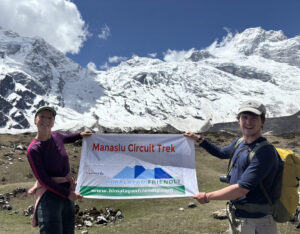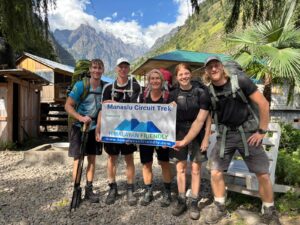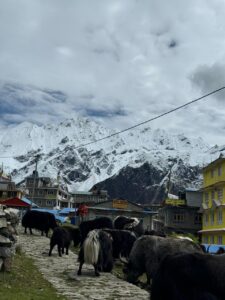This full detail information will help and support to plan, and prepare with the Manaslu Circuit Trek Packing List.
Himalayan Friendly with its expert guides and staff will certainly make your adventure to Manaslu Circuit. Mesmerizing and enjoyable throughout the trekking with kind care and friendly services, which will make your adventure worth-while. Manaslu Circuit trek is an adventure that takes you around the massif range of Manaslu Himal. Located Nepal’s Far North Mid-West around the district of Gorkha with Gandaki Zone. Which is also falls en route to major ancient Trans Himalayan Salt and Caravan Trade Route of Nepal and Tibet.
In the early day’s caravan of mules, horses and yaks laden with goods from both sides of the borders. Which passed through the Upper Manaslu Valley, where our adventurous walks lead you around. Mt. Manaslu rises at 8,163 m/26.782 feet, as the world’s 8th peaks, located within Mansiri Himalayan range.
It is close to Ganesh Himal in the east with Annapurna and Lamjung Himal towards west. On the North west of Manaslu Himal lies a renowned Tsum valley. The higher Manaslu Valley remained forbidden for many years after 1960’s, Tibet was annexed with the main land China. Due to its close boundary between Nepal and Tibet, China was closed for outside visitors until 1991. At that time the trail, bridges and lodges was under developed, as the flow of foreign visitors increased. Then the route to Upper Manaslu and towards the end of trekking, the waking path with bridge are well maintained.
From the last few years, the lodges and guest houses have mushroomed, at every designated overnight stops. Providing more facilities for the trekkers with good accommodations and foods, along with traditional services and hospitality.
Although the Upper Manaslu was opened for outside travellers, but it is designated as Restricted Area. Especially from Jagat Village onwards until you cross the high Larke-La Pass to reach Manang district. Where all trekkers require to obtain, a special permit to enter the former upper valley of Manaslu.
Preparation For Manaslu Circuit Trekking:
After going through all the needful information from the websites or brochures etc. As per your interest, by acquiring the information on the Manaslu Circuit, the trekking routes. Including difficulty and high altitude sickness of HAS, as well as the local native cultures and the trip cost.
As per the itinerary provided, inclusive and exclusive, all trekkers need a minimum of more than two weeks’ holiday. The Manaslu Circuit most itineraries with 12 nights and 13 days trekking duration from Kathmandu to Kathmandu. Trekkers interested in Manaslu Circuit, on booking with Himalayan Friendly, then search for the airlines.
For the shortest routes to Kathmandu and Nepal International Airport. Few airlines fly directly to Kathmandu from European countries, as well as from other Asian countries. After getting the airline tickets for both ways as well can obtain a Nepal Entry Visa on arrival. After carrying the necessary documents required for the visa as well as for the trekking permits.
Before and after booking for Manaslu Circuit Trekking, one needs to be physically for and in good health. As well needs some exercise before departing for Nepal, like an hour of walking, jogging, or any other outdoor exercise. Keeping fit for the treks, as Manaslu Himalaya and other high Himalayan areas are steep ups and downhill.
According to the clothing and gear list for the treks, and as per the season, wise. Then try to get needful gear for the trekking to Manaslu, most of the equipment and trekking gear. Can be bought or hired in Kathmandu at Trekking and Mountaineering shops and stores. If it is too much to carry from home as well as taking care of baggage weights allowed on international airlines.
Most of the clothing and gear list will be provided, by the company that you booked with for Manaslu Circuit. Trekkers need to check their health with doctors or medical experts and gather much information about Manaslu Circuit trekking trails. It will be good to know beforehand the local cultures of Nepalese and the Manaslu people. The other preparation is buying and packing the right gear for the trek, as per the list provided by respective agents.
Clothing and preparation season-wise for Manaslu Circuit Trekking, and lastly getting the medical and travel insurance.
Travel and Medical Insurance are important, especially when visiting high Himalayan countries like Nepal and Manaslu Circuit.
Travel Insurance in case of bad unfavorable weather conditions. Sometimes, the trek has to be re-routed or delayed, and it can lead to cancellation due to landslides, avalanches, broken trails, or political situations. In this condition, which rarely happens, but needs to be on the safe side. This is when your travel insurance comes in handy to get reimbursed extra money incurred due to the above cause and situation.
Medical Insurance applies if someone gets very sick due to illnesses like AMS (Acute Mountain Sickness). Due to sickness or sudden accidents, where trekkers cannot continue the trek and have to break the journey.
A very sick person needs to be evacuated as fast as possible by any means of transportation, including the Helicopter service.
Extra medical bills, for private transportation, or using the helicopter services. Your Medical Insurance can cover some of the expenses incurred.
Things To Know For Manaslu Circuit Trekking:
The Manaslu Circuit Trekking falls within a Restricted Area in Nepal, where visitors are not allowed solo or individual trekking. The company booked with will provide an expert guide and trekking staff as per the group size.
Always leave for trek by checking the Best Time for Manaslu Circuit Trek. It falls under the season September to November when the weather is clear and scene is clear.
It includes porters to carry heavier baggage of an average of 15 to 25 kgs. While the trekkers will be carrying a small or moderate size backpack or Rucksack. Carry the necessary items for the day and the rest of the heavier gear is carried by our porters. You will receive the baggage before or after you arrive at a designated overnight stop.
On treks the trekking permits will be your passport, the rest of the valuables, and documents or items. Can be stored in the hotel or with the company, and the bigger baggage or duffel bags for trekking. The duffel bags and rucksacks can be bought in Kathmandu also, sometimes as per trek cost packages. The company the one you have booked with provides the duffel bags with the company logos.
If you don’t have a habit of trekking, don’t rush for a long trek, first start with the Manaslu Trek designed for beginners.

Packing List For Manaslu Circuit Trek:
Best Packing lists for the Manaslu are also useful for the other treks around the Himalayan regions. Himalayan Friendly will provide lodging, three meals a day, a sleeping bag, a duffel bag, and a down jacket. Apart from the list of items and gear to bring.
- Travel Documents and Cash:
A passport should be valid for a minimum of 6 months for a valid visa. Keep the passport and needed documents handy. Required, at the airport counter and immigration. Carrying a few photocopies of your documents will be very handy in getting your permits, local SIM card, etc. 4–8 copies of photos the size of a passport (required when purchasing a local SIM card or getting permits at some trekking trails).
At least $200 to $300 in cash, as most teahouses and cafes on the Manaslu trekking trail will not accept cards. On trekking routes, you won’t find any ATMs or other services. Instead of your passport, you can use any other valid ID as well as the trekking permits.
- Clothing for Manaslu Circuit Trekking:
Around the Himalayas and Manaslu region, nearly all seasons with cold temperatures. Especially during the morning before the sun comes, late afternoon and night times. Spring and autumn are the best seasons, from March to May and September to early November. The lower valley and mid-hills can be hot with a sub-tropical climate. But from Jagat onwards and above 1,800 m, one can feel the cold temperature during the trek.
Laundry services are not available on leaving Kathmandu need to bring enough clothes to last for two weeks.
- Headwear: Hats with a brim or a sun cap:
Hats with a wide brim to protect ears, neck, and face from the strong sun and UV rays. It will keep you safe from being sunburned, as well as from dehydration, and getting headaches from the direct sunlight.
- Bandanna or Head Scarf:
It protects you from dust and cold wind depending upon the weather and altitude wise. The trekking trails in some areas are dusty, bandana or scarf will be very useful.
- Woolen tops for evening and night time:
Around the higher altitudes, it gets really cold at night. To stay warm in the cold weather, you will need a warm fleece or knit woolen hat. You will need a proper scarf to keep your neck warm, cover your mouth, and keep your lips from getting cold. We recommend a scarf to keep your throat from getting dry air and dust.
- Headlamps:
Very handy, during evening and dark area, including the nights, sometimes the trek starts early morning. Needs the support of a headlamp, some lodge rooms do not have much light powers. As a safety measure, we suggest that you bring extra batteries for the headlamps/ torch.
- Sunglasses or Goggles:
The walk takes you above 3,000 meters high, during the day the sun can be bright due to thin air. The direct sunlight with strong UV (Ultra Violet) can easily burn the skins and effect the eyes with glare. As well as to protect from the bright reflection on snows, which can lead to snow blindness. Best to wear polarized sunglasses with UV protection.
- Trekking Gear and Equipment:
The items on the packing list, includes sleeping bags, clothes, and other normal accessories. It will be in a duffle bags, carried by porter, mules or yaks sometimes. Most of the time, duffle bags are easier to pack and unpack, it should be comfortable for porters to carry.
- Four Seasons Sleeping Bags:
If it is not provided by the company, as included or excluded on the trip cost packages. Better to carry your own sleeping bags, which is safe and hygienic than using the lodge blankets. Make sure that you get a high-insulation down sleeping bag that keeps you warm against the wind chill and snowstorms. Himalayan Friendly also provides you a good sleeping bag, if you have not brought or rented.
- Trekking/ Ski Poles (Collapsible):
Trekking or known as Ski poles, is a big support, especially climbing on steep ups and going downhill. Provides good balance and stability as you climb up the snowy ridge, much better for downhill. Saves you from getting sore knees and muscle cramps.
- Backpack/Rucksack (30–35L):
For your personal necessary items for the day treks, all needs a good and comfortable daypack. Bigger the better to carry water bottles, camera, cell phone, snacks, wet tissues, wallet, and other accessories. We recommend a 30–35L daypack with a hip belt for support and an inner frame for comfort.
Trekking Accessories:
- Cover for Backpack (Optional):
To l keep your back pack or rucksack dry, and from dirt. - Stuff Sacks, Dry Bags, and Ziploc Plastic Bags:
On treks, most lower mid-hill can get rain sometime even in the best time of the seasons for trekking. In keeping your back pack or duffel bags dry, with items inside. Use stuff sacks or Ziploc bags to put clean clothes in one place, and dirty clothes in another. You can also use these bags to wrap all your clothes or other electronics to protect them from the rain. - Bottle of water Sigg or Nalgene:
Trekkers needs to bring a reasonable size water bottle, for the trek and carry during the day. Bring two Nalgene or Sigg light metal bottles or similar. You can fill these bottles with boiling water, and at night and use them as hot water bags to keep warm. As well as for drinking, when on trekking. - Note books & Diary:
After the day treks, at leisure time, you might want to write about the day events and activities. So that you remember the places of good and hard times on Manaslu Circuit Trekking. Catching all the memories on the dairy or note books, as well as address of other group members. Including guides and staff or even of local villagers that you had interact.




